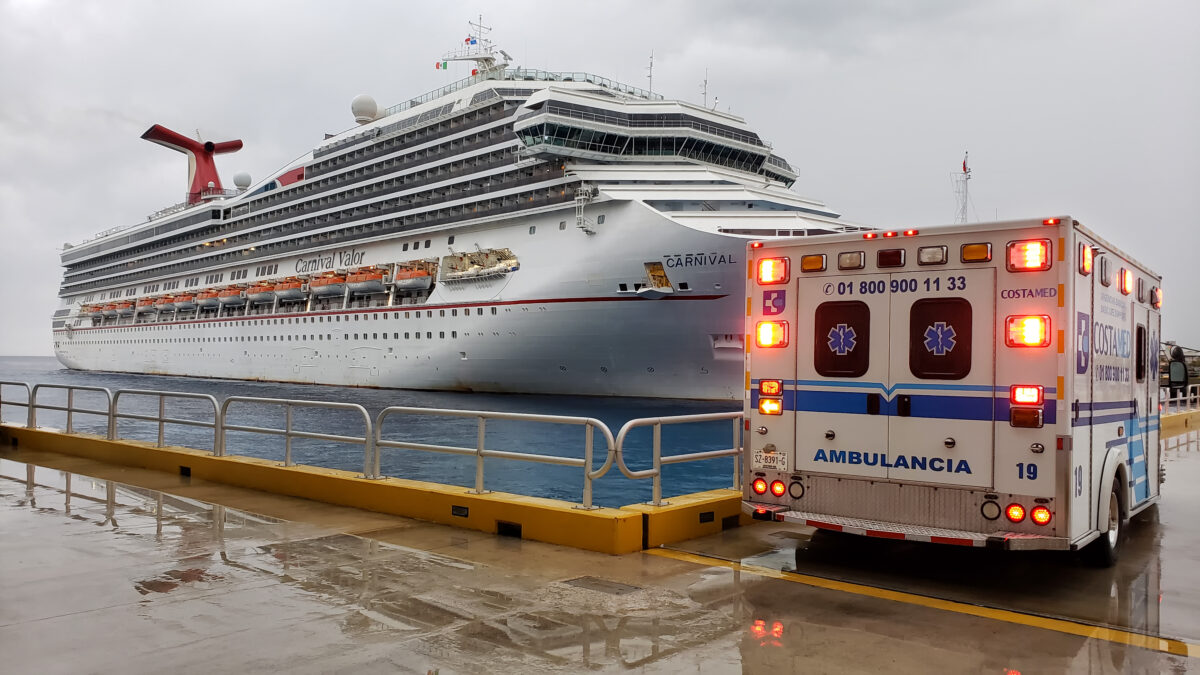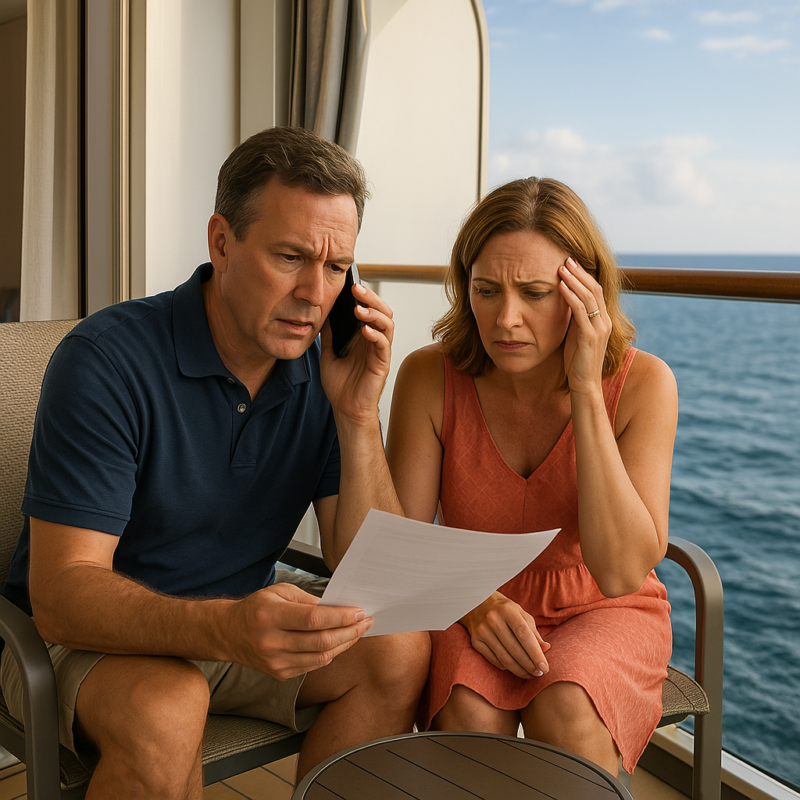Planning a cruise should be exciting, but overlooking travel insurance could turn your dream vacation into a nightmare. Many cruisers skip this crucial protection because of persistent cruise insurance myths and misconceptions. Let’s separate fact from fiction so you can make informed decisions about protecting your cruise investment.
Travel insurance isn’t just an optional add-on—it’s a vital safeguard against the unexpected events that can derail even the most carefully planned cruise vacation. From medical emergencies at sea to lost luggage and trip cancellations, having the right coverage can make all the difference between a minor inconvenience and a major financial disaster.

Let’s debunk the most common myths that might be keeping you from protecting your cruise vacation appropriately.
Myth #1: “My credit card already provides enough coverage.”
Many cruisers believe their credit card’s travel benefits offer sufficient protection, but this is rarely the case for cruise vacations. While some premium credit cards do provide limited travel benefits, they typically fall short in several crucial areas:
• Medical coverage at sea is often minimal or nonexistent
• Emergency evacuation (which can cost $50,000+) is rarely included
• Coverage limits are typically much lower than standalone policies
• Pre-existing conditions are almost never covered
Before relying on your credit card’s protection, carefully review exactly what is and isn’t covered. You’ll likely discover significant gaps that could leave you vulnerable during your cruise. Remember that medical care on cruise ships operates on a fee-for-service basis and can be surprisingly expensive.
Myth #2: “My regular health insurance works everywhere.”
This misconception can lead to serious financial consequences. Most standard health insurance plans provide limited coverage—or none at all—once you leave your home country or sail into international waters.

Cruise ships have medical facilities that function as private practices, meaning:
• They require payment at the time of service
• They don’t accept most domestic health insurance plans
• They charge premium rates for even basic medical care
• They may need to evacuate you to a land-based hospital for serious conditions
A proper travel insurance policy will cover onboard medical expenses and, crucially, emergency medical evacuation. This coverage alone can save you tens of thousands of dollars if you need to be airlifted from the ship to a hospital.
Myth #3: “Travel insurance is too expensive.”
When you’re already spending thousands on a cruise vacation, adding a few hundred more for insurance might seem unnecessary. However, this perspective overlooks the true value proposition:
For typically 5–10% of your total trip cost, you can protect your entire investment and gain coverage for potential medical emergencies. When you break it down, comprehensive travel insurance often costs just a few dollars per day—a small price for significant peace of mind.
The real expense comes when you travel without insurance and face an emergency. A medical evacuation from a cruise ship can easily exceed $50,000, while even a simple treatment in the ship’s medical center can run hundreds of dollars.
Myth #4: “Cheaper policies are adequate.”
It’s tempting to save a few dollars by picking the cheapest insurance you can find—but this shortcut can backfire quickly.
Budget policies often come with major limitations:
• Lower coverage limits for medical emergencies or trip cancellation
• More exclusions and loopholes that limit what’s actually covered
• Higher deductibles you’ll need to pay out-of-pocket
• Slower, less user-friendly claims processes
Don’t let a low premium lull you into a false sense of security. As we’ll see in the next myth, not all insurance policies offer the same protection. Paying a little more for a higher-quality plan can save you thousands if something goes wrong.

Myth #5: “All travel insurance policies are the same.”
This one catches many people off guard. It’s tempting to think that all policies offer the same protection, but the details vary significantly.
Just because two policies seem similar doesn’t mean they offer the same protection. Travel insurance varies significantly in what it covers, how it defines covered events, and how it handles claims.
Some plans focus primarily on trip cancellation, while others emphasize medical coverage. Certain policies may exclude common cruise scenarios, like missed ports or delayed embarkation. And features like “cancel for any reason” (CFAR) coverage are usually only found in premium plans.
Even if the price and policy name look the same, read the fine print. Coverage limits, exclusions, and claim rules can vary more than you’d expect. Comparing policies side-by-side—especially through marketplaces like Squaremouth or InsureMyTrip—can reveal crucial differences that affect your real-world protection.
Myth #6: “Pre-existing conditions are never covered.”
Many cruisers with health conditions assume they can’t get coverage, but this isn’t necessarily true. While pre-existing conditions can complicate insurance matters, many policies offer pre-existing condition waivers if you:
• Purchase your policy within 14–21 days of making your initial trip deposit
• Insure the full pre-paid, non-refundable cost of your trip
• Are medically able to travel when you purchase the policy
These waivers don’t cost extra, but they do require you to act quickly after booking your cruise. Without this waiver, any claim related to a pre-existing condition will likely be denied, so don’t delay if you have health concerns.

Myth #7: “‘Cancel for any reason’ means I get a full refund.”
This popular upgrade can be a smart addition to your policy—but it doesn’t mean unlimited cancellation rights.
The “Cancel for Any Reason” (CFAR) option sounds comprehensive, but it comes with important limitations:
• It typically reimburses only 50–75% of your trip costs, not 100%
• You must purchase it shortly after your initial trip deposit (usually within 14–21 days)
• You must cancel your trip at least 48–72 hours before departure
• It costs approximately 40% more than standard trip cancellation insurance
CFAR coverage provides valuable flexibility, especially in uncertain times, but understand exactly what you’re getting before paying the premium. Standard trip cancellation insurance covers many common reasons for cancellation at 100%, so CFAR is best for those who want additional flexibility beyond those covered reasons.
Myth #8: “I don’t need insurance for short cruises.”
A quick weekend getaway may feel low-risk, but travel problems don’t care how long you’re gone. Even a two-night cruise can go sideways.
The length of your trip doesn’t affect whether problems occur—only how long you’re exposed to potential issues. Even on a short cruise, you can experience:
• Medical emergencies that require evacuation
• Trip delays or cancellations
• Lost or delayed luggage
• Missed connections
The cost of insurance for shorter trips is proportionally less expensive, making it an even more reasonable investment. Don’t let the brief duration of your cruise lull you into a false sense of security.
Myth #9: “You can buy travel insurance at the last minute.”
It’s technically true that you can buy insurance late—but doing so can mean missing out on key benefits. Timing matters.

Many valuable insurance benefits are only available when you purchase your policy within a specific timeframe after making your initial trip deposit—typically 14–21 days. These time-sensitive benefits often include:
• Pre-existing medical condition waivers
• “Cancel for any reason” coverage
• Financial default protection
• Terrorism coverage
Additionally, once a named storm has been identified, insurance won’t cover cancellations related to that specific storm. Similarly, you can’t purchase insurance after you’ve become ill or after another covered event has occurred.
For maximum protection, it’s best to purchase travel insurance soon after making your initial cruise deposit. This ensures you’ll have access to all available benefits and the longest period of cancellation coverage.
Myth #10: “Policy details aren’t important to review.”
Too many travelers treat travel insurance like a checkbox. But if you don’t read the fine print, you might discover too late that you’re not covered the way you thought.
Each policy has specific definitions, requirements, and exclusions that determine whether a claim will be paid. For example:
• What qualifies as a covered reason for cancellation
• How the policy defines travel delays and what expenses it will cover
• What documentation is required when filing a claim
• Which activities or situations are excluded from coverage
According to industry studies, nearly 30% of travelers don’t thoroughly read their policy details. This oversight can lead to denied claims and unexpected expenses when you’re most vulnerable.
Taking the time to understand exactly what your policy covers before your cruise can prevent unpleasant surprises and ensure you have the protection you need for your specific concerns and activities.

Crush Cruise Insurance Myths: Tips for Choosing the Right Policy
Now that we’ve cleared up these common misconceptions, here are some practical steps for selecting the right policy for your cruise:
- Compare multiple policies using reputable comparison sites
Use travel insurance marketplaces like InsureMyTrip or Squaremouth rather than simply accepting the cruise line’s default offering. These platforms let you compare coverage limits, exclusions, and customer reviews, helping you make an informed decision. - Purchase insurance early—ideally within two weeks of your initial cruise deposit
Timing matters. Buying early gives you access to time-sensitive benefits such as pre-existing condition waivers, “Cancel for Any Reason” (CFAR) coverage, and protection against financial default or terrorism-related cancellations. - Check that your policy includes cruise coverage explicitly
Some general travel insurance policies don’t cover cruise-specific risks like missed ports, emergency tender transfers, or onboard medical treatment. Always verify that your policy explicitly mentions cruise travel. - Ensure your policy includes adequate medical evacuation coverage
For international cruises, look for policies that include a minimum of $250,000 in medical evacuation coverage. Helicopter evacuations and airlifts from ships can cost tens (or hundreds) of thousands of dollars. - Verify coverage for planned excursions or activities
Not all policies automatically cover high-risk shore excursions like snorkeling, zip-lining, or ATV tours. If your cruise includes adventure-based activities, make sure your policy includes these or offers optional riders. - Read the fine print before purchasing
Don’t skip this step. Review the claim filing requirements and any exclusions in advance so you understand what documentation you’ll need if something goes wrong—especially for cancellations, delays, or medical emergencies. - Match the policy to your specific travel needs
Seniors may want higher medical limits and emergency care coverage. Families might prioritize substantial trip interruption benefits. Think about who’s traveling, where you’re going, and what kind of backup you’d want if plans change unexpectedly.

Filing a Successful Claim
Even the best policy won’t help unless you know how to use it. If something unexpected happens, these steps can improve your chances of a smooth, successful claims process:
• Report incidents as soon as possible—most policies have strict deadlines, and some require you to notify the insurer’s emergency hotline during your trip
• Document everything with photos, receipts, and official reports (police, airline, shipboard staff, etc.)
• Keep all medical records and itemized bills if you receive treatment
• Be honest and thorough—inaccurate or exaggerated claims may be denied
• Follow up regularly using your insurer’s online portal or claims department
• File an appeal if your claim is denied and you believe it was wrongfully rejected—additional documentation often helps
• Ask your travel advisor for help if you used one—they may be able to advocate or clarify details with the insurer
Closing Thoughts
Travel insurance isn’t just an extra expense—it’s a smart, essential part of responsible cruise planning. By understanding the truths behind these common myths, you can protect not just your travel budget but your peace of mind.
Don’t let misinformation or hesitation leave your vacation vulnerable. Review your options and choose the coverage that fits your needs. Your cruise deserves better than wishful thinking. Insure it.

